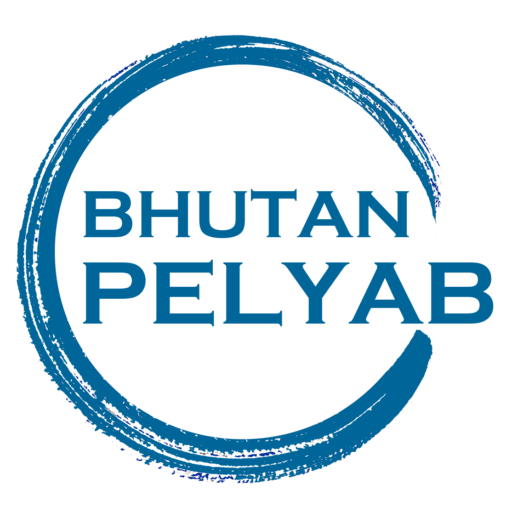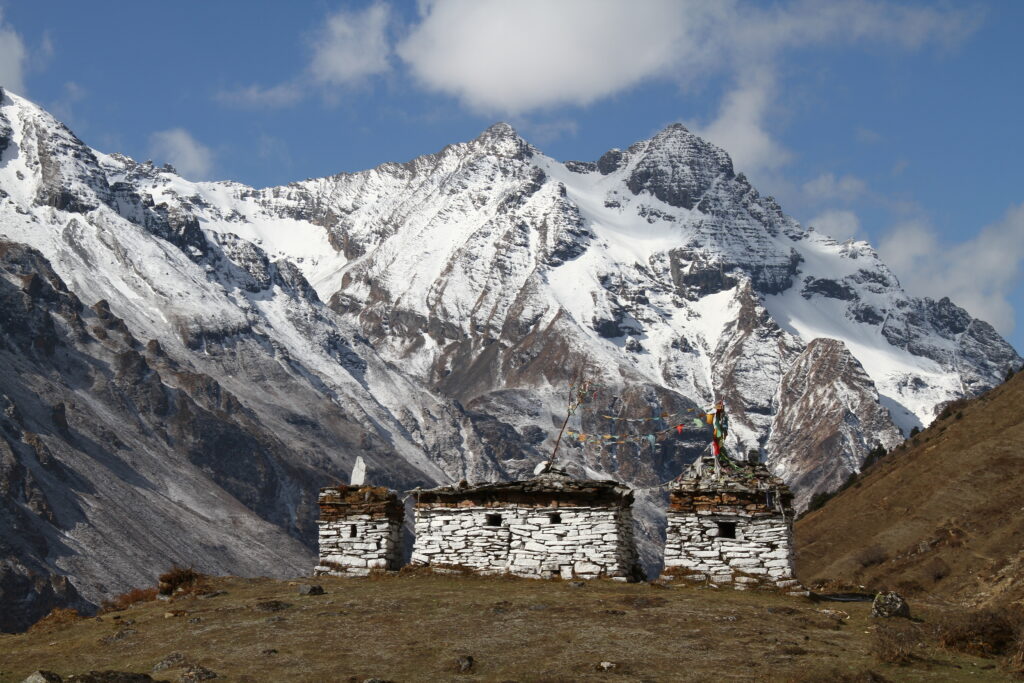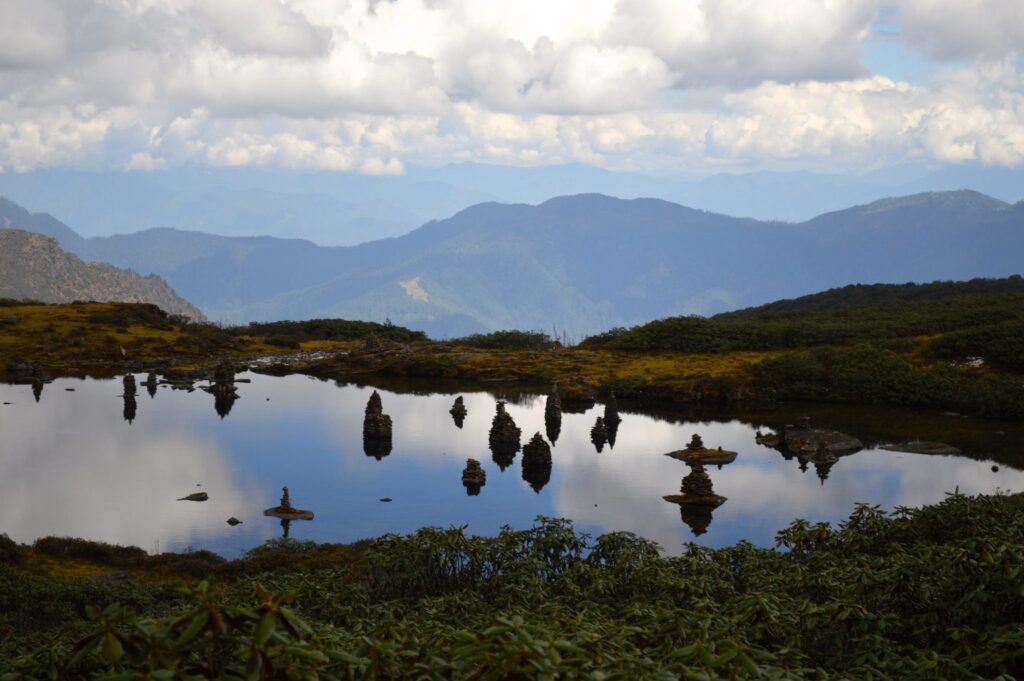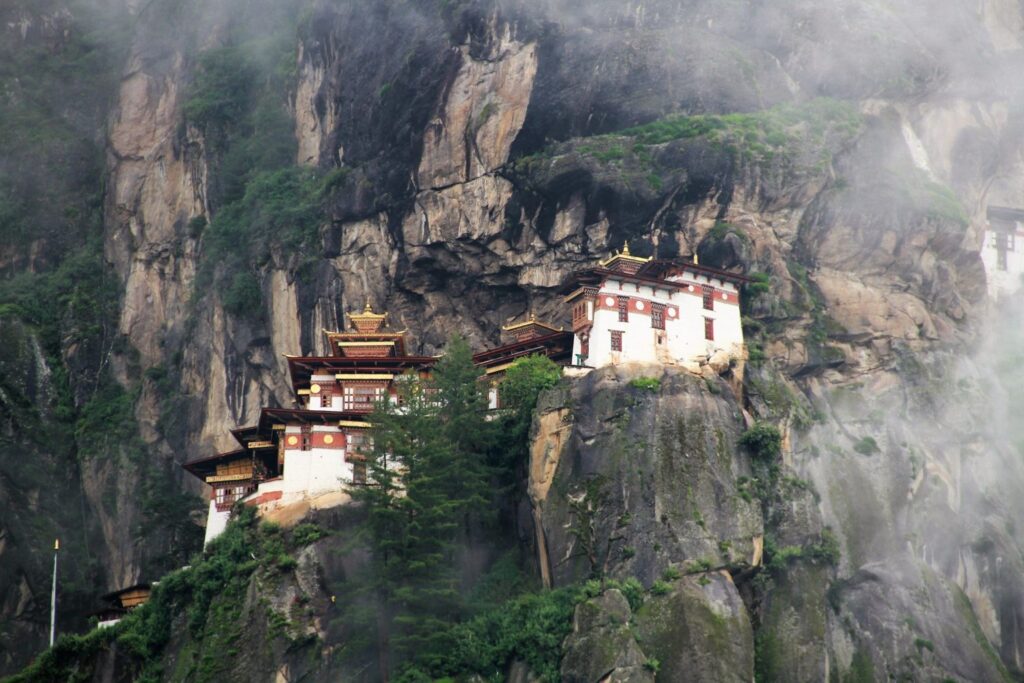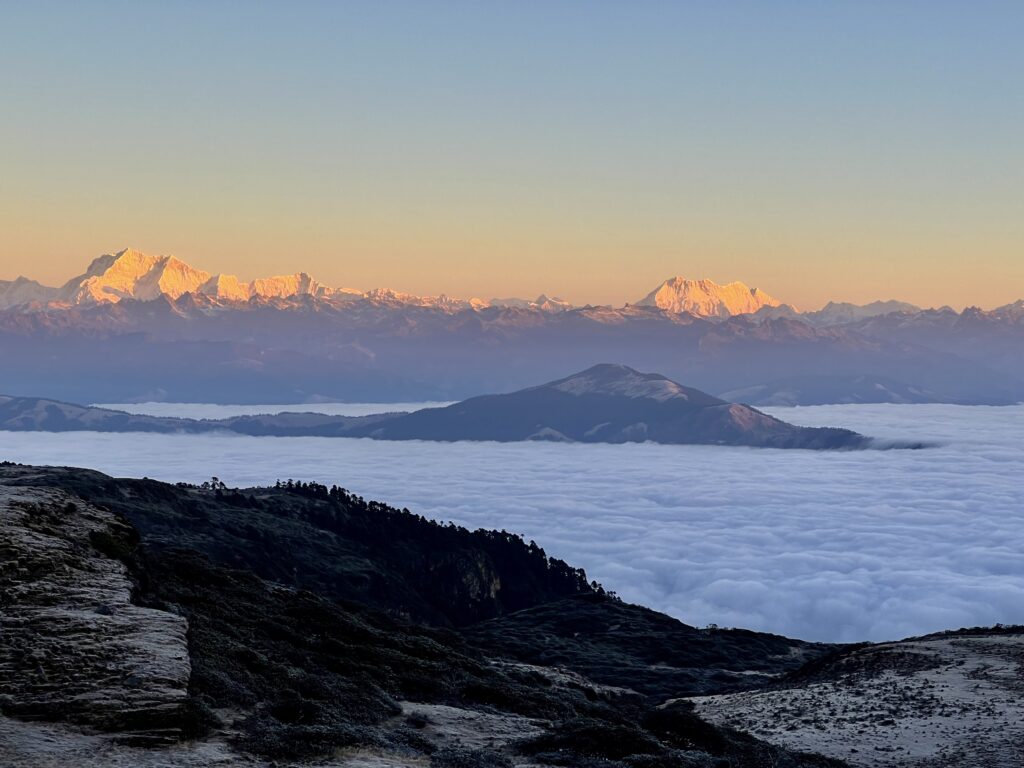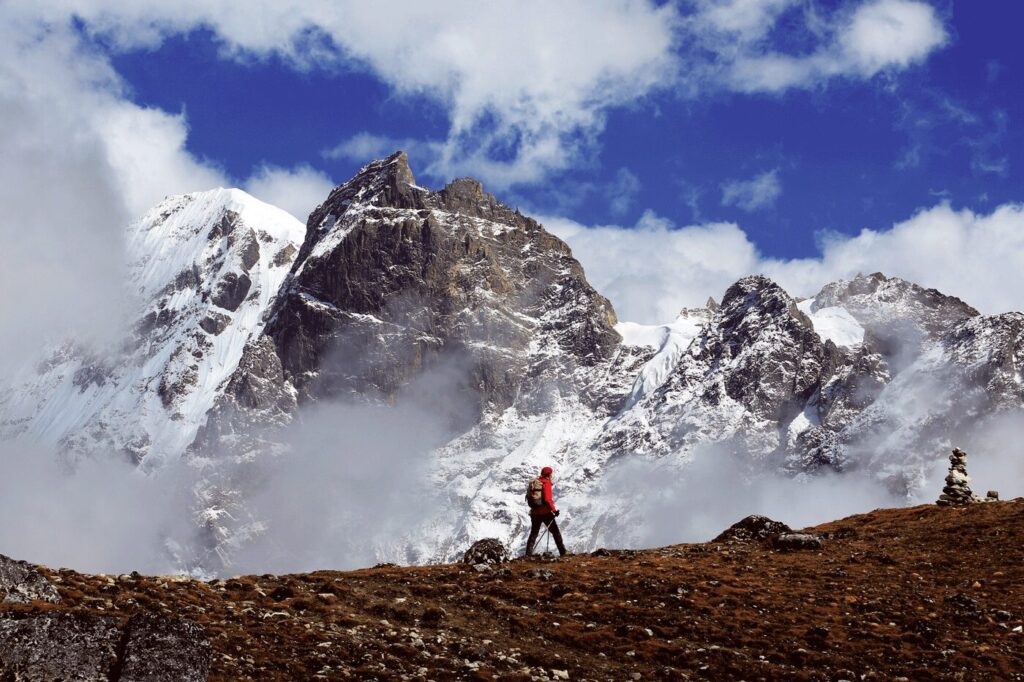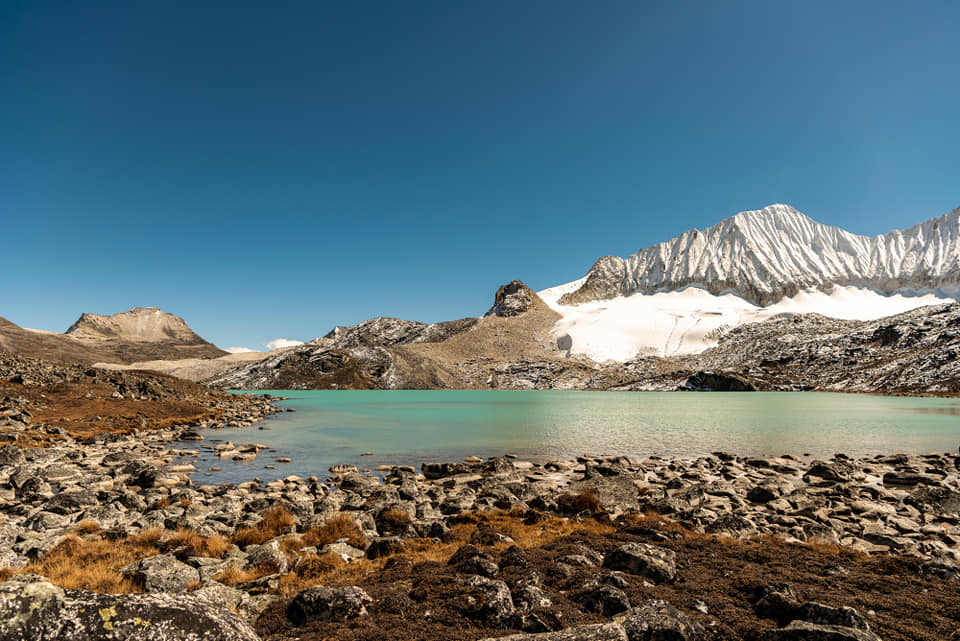Day 01: Arrive in Paro and travel to Thimphu
- Altitude in Paro: 2,300m
- Altitude in Thimphu: 2,400m
- Distance: 55km
- Estimated travel time: 1.30hrs
As your plane approaches Paro – the only international airport in Bhutan, take a look outside to catch the breathtaking view of the Himalayan ranges from above. You will be first welcome with the cool, clean fresh air once you step outside of the plane, definitely a nice start for your Bhutan trip.
After meeting with our representative, you will travel to Bhutan’s capital – Thimphu. We will pay a visit to the beautiful Tachogang Lhakhang (Temple of The Excellent Horse), which was the work of the famous bridge builder Thangtong Gyalpo (1385-1464).
We will have a brief rest at the hotel in Thimphu before heading to the National Memorial Chorten, established in 1974. The construction serves as a monument to world peace and as a memorial to the Third King, His Majesty Jigme Dorji Wangchuk after he passed away.
From there, we will get to Buddha Point (Buddha Dordenma Statue), one of the largest buddha statues in the kingdom and in the world. The golden Buddha sits on a gilded meditation hall, and its total height is 51.5m. The statue is located atop a hill in Kuenselphodrang Nature Park, so after offering your prayers, you can walk around to enjoy the picturesque scene of Thimphu from here.
We will see the imposing Tashichho Dzong (Fortress of The Glorious Religion) in the afternoon. The edifice was built in 1216 A.D and has gone through reconstructions over the years. The impressively large dzong sits next to the bank of Wang Chhu river and is surrounded with green grass fields. The Third King made this dzong to be a symbol of Thimphu after it was chosen as the new capital.
Returning to Thimphu town, we will have time to wander around to experience the lively atmosphere. You will see more than just historical sites and important landmarks, life in Bhutan is also about the clatter on the streets, the crowded shops and bazaars and the image of the locals, in their national attire, happily shopping and chatting.
We will stay overnight at the hotel in Thimphu.
Day 02: Thimphu to Gangtey
- Altitude in Gangtey: 2,900m
- Distance: 160km
- Estimated travel time: 6hrs
Today we will drive to Gangtey (or ‘Phobjikha valley’), probably one of the most picturesque valleys in Bhutan. We will stop at Dochula pass, which is on top of a mountain at an altitude of 3,050m. Thanks to its ideal location, the pass is favoured by travelers since they can get the magnificent panoramic view of the eastern Himalayan ranges from here. The picture of 108 sacred chortens gracing along the green hillside and the snowcapped mountain peaks behind the thick veils of clouds is definitely one of the most stunning sights you will ever come across. Then we will continue on the highway, which follows the scenic Dang Chhu river before climbing through forests of bamboo and oak.
On arrival in Gangtey, we will first visit Gangtey Goemba, the only Nyingmapa monastery in this region. The extensive goemba sits on a forested hill overlooking the beautiful green landscape of the whole valley.
We will stay at the hotel in Gangtey.
Day 03: Gangtey to Trongsa
- Altitude in Trongsa: 2,200m
- Distance: 70km
- Estimated travel time: 3hrs
There are several hikes that are popular for visitors in Gangtey, and Gangtey Nature Trail has one of the most pleasant routes for you to discover the fertile valley. Our journey will start from the small hilltop overlooking Gangtey Goemba, then walk down to the lovely flower fields and to Semchubara village. The trail will lead through unspoiled forests of blue pines, where we can enjoy the relaxing earthy scents. We will get to a valley viewpoint and the walk will finish once we see the small Khewang Lhakhang (Khewang temple).
We will also go into the Black–necked Crane Visitor Centre, which is close by. The center is a great place to get more information about the endangered bird, the nature and culture of Gangtey valley. Moreover, this is a place from which you can spot the cranes as they come here in the winter.
Leaving Gangtey, the next destination is Trongsa, one of the most historic towns in Bhutan. The first site we will see is the famous Royal Heritage Museum (Ta Dzong) of Trongsa. It stands on a promontory above Trongsa town, and was the watchtower of Trongsa Dzong from the time of internal rebellion. Later, it was converted into the National Museum and now is one of the most impressive museums in Bhutan with massive collections dedicated to the Wangchuck dynasty.
Located next to the old watchtower is Trongsa Dzong, arguably the most majestic dzong in the whole kingdom. Built in 1644, high above the roaring Mange Chhu river, the dzong is a spectacular sight to admire from anywhere in town. The assemblage of buildings trails down the ridge and sometimes disappears into the veils of cloud on its south side only makes the whole picture more attractive and mystical. The grand complex was the Wangchuck dynasty’s seat of power before they became rulers of Bhutan in 1907.
We will stay overnight at the hotel in Trongsa.
Day 04: Tongtongphey – Jangbi Village
- Distance: 8km
- Estimated time: 4hrs
- Camp altitude: 1,500m
- Ascent: 950m; descent: 600m
Today is the first day of our 4-day trek to explore more of Trongsa Dzongkhag.
We will have time for breakfast at the hotel and also to wander around Trongsa town before driving for about 45 minutes to Tongtongphey.
We will meet and follow the village guide down to the Mangdi Chhu, where we will cross a suspension bridge. The area around the suspension bridge is where we can catch sight of the rare Golden Langurs, which can only be found in a few areas in Bhutan and India.
You will also have the opportunity to come in contact with the Monpas, believed to be the first inhabitants in the country. The small traditional villages of the Monpa community are scattered on the slope overlooking Mangdi Chhu.
The campsite in Jangbi is on the valley sill, which offers a grand view of the verdant Mangdi valley.
Day 05: Jangbi Village – Kudra Village
- Distance: 13km
- Estimated time: 6hrs
- Camp altitude: 1,400m
The second day of the trek is the most demanding with steep hikes and descents.
You can spend time learning more about the life of the Monpas and also paying a visit to the orchid garden, where they plant about 75 different orchid species. On the way to Kudra, we will trek pass stone imprints of Guru Rinpoche’s footprints.
Shortly after lunchbreak, we will arrive at Phumzur, one of the Monpa villages. Then we will quickly explore the Lhakhang village in Phumzur and continue on our way to the campsite in Kudra. The trail will lead us to another small village, Lekpogang, and we can reach the campsite after another hour of walking. The campsite’s location allows us to get a bird’s-eye view of both Nyimshong village and Zhemgang town.
Day 06: Kudra Village – Nabji Village
- Distance: 12km
- Estimated time: 6hrs
- Camp altitude: 1,300m
From Kudra village to Nabji village, our path will cross a collage of streams, waterfalls and dense forests, which will give you a refreshing feeling of real wilderness experience. It is easy to spot some animals such as Himalayan Squirrels, Rhesus Mecaques, and small snakes as we walk. Once we arrive at the holy tree in Nabji, the villagers will give us a warm welcome. The serene village is very scenic with clustered houses surrounded by green paddy fields. Asides from the holy tree, there are some other religious sites in the village that you can visit – a stone with a ‘bell’ in it, made by Guru Pema, and a big stone, close to Nabji Lhakhang, split in two to hide valuable things in case of war.
Day 07: Nabji Village – Korphu Village
- Distance: 4km
- Estimated time: 1.30hrs
- Camp altitude: 1,300m
On the way to Korphu, we will visit Nabji temple, which stands amidst the paddy fields. The small temple houses a stone pillar on which Guru Rinpoche had imprinted the thumbs of two warring kings as a symbol of resolution after bringing about peace.
Korphu village is located on a mountain top at an altitude of 1,500m. The trail leads to the village is quite spectacular with a wonderful view of the surrounding valleys. The most memorable thing about this village is the hospitality of the people. You will have the option of being greeted with a traditional ‘Chipdrel’ procession and a ‘Marchang’ ceremony, practices typically reserved for royalty. The villagers will have cultural shows full of singing and dancing for visitors, and also perform the traditional ‘Tashi Labey’ dance to bid you farewell.
Moreover, you can see the village temple which preserves the sacred relics of Pema Lingpa, the legendary Terton or ‘Treasure revealer’ in Bhutan. We will have lunch at the village campsite, which offers a wonderful view of Nabji and its surrounding areas.
Day 08: Korphu Village to Trongsa
- Distance: 100km
- Estimated travel time: 6hrs
Today is the last day of the trek. There will be a car to drive us from Korphu village back to Trongsa.
We will stop at Kinga Rabten, the winter palace of Bhutan’s Second King. The visit will show us a great insight into the early days of Bhutan’s monarchy. On the way there we will pass below Takse Goemba, a giant waterfall and rice paddles of the lower Mangde Chhu valley.
We will stay overnight at the hotel in Trongsa.
Day 09: Trongsa to Punakha
- Altitude in Punakha: 1,300m
- Distance: 137km
- Estimated travel time: 4hrs
We will travel to Punakha, the old capital of Bhutan and visit Punakha Dzong (Palace of Great Happiness). The remarkable structure stands at the junction of the two rivers Pho Chhu and Mo Chhu, which create the fertile Punakha valley. The 17th-century fortress is the second largest in Bhutan and is notable for containing the preserved remains of Zhabdrung Ngawang Namgyal, the country’s unifier. The sight of Punakha Dzong with its impressive white, embraced by the rivers and the green landscape is exceptionally captivating!
We will also visit the Pho Chhu suspension bridge, the longest suspension bridge in Bhutan. The bridge itself is a spectacular construction, which stretches 160m over the fast-paced river. It also offers visitors an incredible view of the lush valleys and the idyllic villages.
If time is permitted, we will walk to Khamsum Yuelley Namgyal Chorten. The special complex was established by the Queen Mother in 2004, and is renowned both for its unique structure and the charming views one can get from the site. The golden-spired stupa is the only one of its kind in the world. It will take 1 hour to hike to the stunning chorten, which sits on a ridge above the lush valley at an altitude of 1,500m and provides a breathtaking view of Punakha valley. The trail to the chorten is really refreshing, passing lovely rice paddies and pine trees on the way.
We will spend the night at the hotel in Punakha.
Day 10: Punakha to Paro
- Distance: 125km
- Estimated travel time: 4hrs
We will drive back to Paro today. On the way, we will take a pleasant hike across hillock fields to Chimi Lhakhang, the Temple of Fertility, built in the 15th century by the “Divide Madman” – Lama Drukpa Kuenley.
In the afternoon, we will get to see Paro Rinpung Dzong (Fortress of The Heap of Jewels), which is highly praised for its impressive architecture. The dzong’s massive buttressed walls that tower over the town are visible throughout the valley. The site is symbolic as the religious and secular center of all affairs of the valley. You will find notable wall paintings along the wooden galleries inside the dzong, which illustrates the famous Buddhist lore. Outside the dzong is a stone-paved festival ground, where the masked dance of the Paro Tshechu Festival takes place is performed every year.
After that we will go to the National Museum of Bhutan (Ta Dzong), the old watchtower of Paro Dzong. The museum is otherwise known for its unique circular construction, resembling a conch shell. You will be able to learn more about life in Bhutan through the extensive collection displayed inside, which includes antique thangka paintings, textiles, weapons, household items and a rich assortment of natural and historic artifacts.
We stay overnight at the hotel in Paro.
Day 11: Paro sightseeing
We will spend the first half of the day hiking up to one of the most sacred sites in Bhutan – Taktsang Monastery, also called ‘Tiger’s Nest’. The grand construction is located on a cliff at an altitude of 3,120m. Legend says that Guru Rinpoche had arrived on the back of a tigress in the 8th century and meditated here for 3 months. The hike to the monastery is 4.5km one way, and has an elevation gain of 900m. As the hike will take 4-5 hours to finish, we will have some stops to enjoy the wonderful scene of Paro valley, with dense forests and great Himalayan mountains. The pristine nature is one of the most precious experiences for travelers to Bhutan.
After that, we will head to Kyichu Lhakhang, one of the 108 imposing temples erected by the Tibetan King, Songtsen Gampo. The temple is intriguing with visitors for its remarkable structure, as well as the sight of pilgrims shuffling around the temple and spinning its many prayer wheels, which is an absolutely captivating ritual to witness.
In the late afternoon, we will join a local family for a special dinner with dishes Ema Datshi, Momos (Bhutanese dumpling), Ara (Bhutanese renowned wine), Buckwheat noodles with spices and veggies and the Hogay salad.
A nice hot stone bath to relax your body after a day of hiking, or spend time wandering through the cool pubs and shops in Paro are some other activities which you can do after dinner. Paro town is renowned for its dynamic nightlife with great live music, delicious snacks and good local alcohol, perfect for your last night in Bhutan.
We will stay the last night at hotel in Paro
Day 12: Depart Paro
After breakfast at the hotel, your guide will accompany you to the airport for flight to your onward destination. Tashi Delek (goodbye and good luck) and we hope to see you again!
